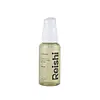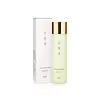What's inside
What's inside
 Key Ingredients
Key Ingredients

 Benefits
Benefits

 Concerns
Concerns

No concerns
 Ingredients Side-by-side
Ingredients Side-by-side

Ganoderma Lucidum Extract 65%
Skin ProtectingButylene Glycol
HumectantGlycerin
HumectantLactobacillus Ferment
Skin ConditioningWater
Skin ConditioningNiacinamide
SmoothingGlycereth-26
Humectant1,2-Hexanediol
Skin ConditioningCaprylyl Glycol
EmollientHydroxyacetophenone
AntioxidantPentylene Glycol
Skin ConditioningXanthan Gum
EmulsifyingEthylhexylglycerin
Skin ConditioningAllantoin
Skin ConditioningBetaine
HumectantDipotassium Glycyrrhizate
HumectantInonotus Obliquus Extract
Skin ConditioningTremella Fuciformis Extract
HumectantCamellia Sinensis Leaf Extract
AntimicrobialAdenosine
Skin ConditioningSodium Hyaluronate
HumectantLactococcus Ferment Lysate
Skin ConditioningSaccharomyces Ferment
Skin ConditioningStreptococcus Thermophilus Ferment
HumectantBacillus Ferment
Skin ConditioningGanoderma Lucidum Extract 65%, Butylene Glycol, Glycerin, Lactobacillus Ferment, Water, Niacinamide, Glycereth-26, 1,2-Hexanediol, Caprylyl Glycol, Hydroxyacetophenone, Pentylene Glycol, Xanthan Gum, Ethylhexylglycerin, Allantoin, Betaine, Dipotassium Glycyrrhizate, Inonotus Obliquus Extract, Tremella Fuciformis Extract, Camellia Sinensis Leaf Extract, Adenosine, Sodium Hyaluronate, Lactococcus Ferment Lysate, Saccharomyces Ferment, Streptococcus Thermophilus Ferment, Bacillus Ferment
Water
Skin ConditioningButylene Glycol
HumectantGlycerin
HumectantNiacinamide
SmoothingCaprylic/Capric Triglyceride
MaskingCetyl Ethylhexanoate
EmollientHippophae Rhamnoides Fruit Extract
Skin ConditioningHippophae Rhamnoides Fruit Oil
Skin Protecting3-O-Ethyl Ascorbic Acid
Skin ConditioningAscorbic Acid
AntioxidantBrassica Oleracea Italica Extract
AstringentAvena Sativa Seed Extract
Skin ConditioningAllium Sativum Bulb Extract
Skin ConditioningEruca Sativa Leaf Extract
Skin ConditioningUndaria Pinnatifida Extract
Skin ConditioningSpinacia Oleracea Leaf Extract
Skin ConditioningCucurbita Pepo Fruit Extract
Skin ConditioningPrunus Amygdalus Dulcis Seed Extract
Skin ConditioningVaccinium Angustifolium Fruit Extract
Skin ProtectingCoptis Japonica Root Extract
Skin ConditioningOlea Europaea Fruit Oil
MaskingOenothera Biennis Oil
EmollientCamellia Japonica Seed Oil
EmollientPerilla Ocymoides Seed Oil
Skin ConditioningPersea Gratissima Oil
Skin ConditioningHelianthus Annuus Seed Oil
EmollientHydrolyzed Hyaluronic Acid
HumectantHyaluronic Acid
HumectantCopper Tripeptide-1
Skin ConditioningTripeptide-1
Skin ConditioningPalmitoyl Tripeptide-1
Skin ConditioningPalmitoyl Pentapeptide-4
Skin ConditioningHexapeptide-11
Skin ConditioningHexapeptide-9
Skin ConditioningSodium Hyaluronate
HumectantBeta-Glucan
Skin ConditioningHydrogenated Lecithin
EmulsifyingCeramide NP
Skin ConditioningDipotassium Glycyrrhizate
HumectantPolyglyceryl-10 Laurate
Skin ConditioningSodium Acetylated Hyaluronate
HumectantSodium Hyaluronate Crosspolymer
HumectantPotassium Hyaluronate
Skin ConditioningHydroxypropyltrimonium Hyaluronate
Polyglyceryl-3 Methylglucose Distearate
EmulsifyingDipropylene Glycol
HumectantHydroxyacetophenone
AntioxidantGlyceryl Stearate
EmollientCaprylyl Glycol
EmollientCellulose Gum
Emulsion StabilisingAcrylates/C10-30 Alkyl Acrylate Crosspolymer
Emulsion StabilisingArginine
MaskingAdenosine
Skin ConditioningDisodium EDTA
1,2-Hexanediol
Skin ConditioningWater, Butylene Glycol, Glycerin, Niacinamide, Caprylic/Capric Triglyceride, Cetyl Ethylhexanoate, Hippophae Rhamnoides Fruit Extract, Hippophae Rhamnoides Fruit Oil, 3-O-Ethyl Ascorbic Acid, Ascorbic Acid, Brassica Oleracea Italica Extract, Avena Sativa Seed Extract, Allium Sativum Bulb Extract, Eruca Sativa Leaf Extract, Undaria Pinnatifida Extract, Spinacia Oleracea Leaf Extract, Cucurbita Pepo Fruit Extract, Prunus Amygdalus Dulcis Seed Extract, Vaccinium Angustifolium Fruit Extract, Coptis Japonica Root Extract, Olea Europaea Fruit Oil, Oenothera Biennis Oil, Camellia Japonica Seed Oil, Perilla Ocymoides Seed Oil, Persea Gratissima Oil, Helianthus Annuus Seed Oil, Hydrolyzed Hyaluronic Acid, Hyaluronic Acid, Copper Tripeptide-1, Tripeptide-1, Palmitoyl Tripeptide-1, Palmitoyl Pentapeptide-4, Hexapeptide-11, Hexapeptide-9, Sodium Hyaluronate, Beta-Glucan, Hydrogenated Lecithin, Ceramide NP, Dipotassium Glycyrrhizate, Polyglyceryl-10 Laurate, Sodium Acetylated Hyaluronate, Sodium Hyaluronate Crosspolymer, Potassium Hyaluronate, Hydroxypropyltrimonium Hyaluronate, Polyglyceryl-3 Methylglucose Distearate, Dipropylene Glycol, Hydroxyacetophenone, Glyceryl Stearate, Caprylyl Glycol, Cellulose Gum, Acrylates/C10-30 Alkyl Acrylate Crosspolymer, Arginine, Adenosine, Disodium EDTA, 1,2-Hexanediol
 Reviews
Reviews

Ingredients Explained
These ingredients are found in both products.
Ingredients higher up in an ingredient list are typically present in a larger amount.
1,2-Hexanediol is a synthetic liquid and another multi-functional powerhouse.
It is a:
- Humectant, drawing moisture into the skin
- Emollient, helping to soften skin
- Solvent, dispersing and stabilizing formulas
- Preservative booster, enhancing the antimicrobial activity of other preservatives
Adenosine is in every living organism. It is one of four components in nucleic acids that helps store our DNA.
Adenosine has many benefits when used. These benefits include hydrating the skin, smoothing skin, and reducing wrinkles. Once applied, adenosine increases collagen production. It also helps with improving firmness and tissue repair.
Studies have found adenosine may also help with wound healing.
In skincare products, Adenosine is usually derived from yeast.
Learn more about AdenosineButylene Glycol (or BG) is used within cosmetic products for a few different reasons:
Overall, Butylene Glycol is a safe and well-rounded ingredient that works well with other ingredients.
Though this ingredient works well with most skin types, some people with sensitive skin may experience a reaction such as allergic rashes, closed comedones, or itchiness.
Learn more about Butylene GlycolCaprylyl Glycol is a humectant and emollient, meaning it attracts and preserves moisture.
It is a common ingredient in many products, especially those designed to hydrate skin. The primary benefits are retaining moisture, skin softening, and promoting a healthy skin barrier.
Though Caprylyl Glycol is an alcohol derived from fatty acids, it is not the kind that can dry out skin.
This ingredient is also used as a preservative to extend the life of products. It has slight antimicrobial properties.
Learn more about Caprylyl GlycolDipotassium Glycyrrhizate comes from licorice root.
Extracts of licorice have demonstrated to have antibacterial, anti‐inflammatory, antiviral, antioxidant properties.
One component, glabridin, has extra potent antioxidant and soothing properties. It has also been found to block pigmentation from UVB rays in guinea pigs.
Licorice Root also contains a flavonoid. Flavonoids are a natural substance from in plants. Flavonoids also have antioxidant properties.
Another component, glycyrrhizin, has been found to have anti-inflammatory and antimicrobial benefits. This may make licorice root extract effective at treating acne. However, more research is needed to support this.
Liquiritin is one of the flavone compounds found in licorice. It has been found to help lighten skin by preventing tyrosinase from reacting with tyrosine. When the two react, protein is converted to melanin. Melanin is the substance in your body that gives your features pigmentation.
Licorice root is native to Southern Europe and Asia. It has been used in traditional Chinese medicine to help with respiratory issues.
Learn more about Dipotassium GlycyrrhizateGlycerin is already naturally found in your skin. It helps moisturize and protect your skin.
A study from 2016 found glycerin to be more effective as a humectant than AHAs and hyaluronic acid.
As a humectant, it helps the skin stay hydrated by pulling moisture to your skin. The low molecular weight of glycerin allows it to pull moisture into the deeper layers of your skin.
Hydrated skin improves your skin barrier; Your skin barrier helps protect against irritants and bacteria.
Glycerin has also been found to have antimicrobial and antiviral properties. Due to these properties, glycerin is often used in wound and burn treatments.
In cosmetics, glycerin is usually derived from plants such as soybean or palm. However, it can also be sourced from animals, such as tallow or animal fat.
This ingredient is organic, colorless, odorless, and non-toxic.
Glycerin is the name for this ingredient in American English. British English uses Glycerol/Glycerine.
Learn more about GlycerinHydroxyacetophenone is antioxidant with skin conditioning and soothing properties. It also boosts the efficiency of preservatives.
This ingredient is not irritating or sensitizing.
Niacinamide is a multitasking form of vitamin B3 that strengthens the skin barrier, reduces pores and dark spots, regulates oil, and improves signs of aging.
And the best part? It's gentle and well-tolerated by most skin types, including sensitive and reactive skin.
You might have heard of "niacin flush", or the reddening of skin that causes itchiness. Niacinamide has not been found to cause this.
In very rare cases, some individuals may not be able to tolerate niacinamide at all or experience an allergic reaction to it.
If you are experiencing flaking, irritation, and dryness with this ingredient, be sure to double check all your products as this ingredient can be found in all categories of skincare.
When incorporating niacinamide into your routine, look out for concentration amounts. Typically, 5% niacinamide provides benefits such as fading dark spots. However, if you have sensitive skin, it is better to begin with a smaller concentration.
When you apply niacinamide to your skin, your body converts it into nicotinamide adenine dinucleotide (NAD). NAD is an essential coenzyme that is already found in your cells as "fuel" and powers countless biological processes.
In your skin, NAD helps repair cell damage, produce new healthy cells, support collagen production, strengthen the skin barrier, and fight environmental stressors (like UV and pollution).
Our natural NAD levels start to decline with age, leading to slower skin repair, visible aging, and a weaker skin barrier. By providing your skin niacinamide, you're recharging your skin's NAD levels. This leads to stronger, healthier, and younger looking skin.
Another name for vitamin B3 is nicotinamide. This vitamin is water-soluble and our bodies don't store it. We obtain Vitamin B3 from either food or skincare. Meat, fish, wheat, yeast, and leafy greens contain vitamin B3.
The type of niacinamide used in skincare is synthetically created.
Learn more about NiacinamideSodium Hyaluronate is hyaluronic acid's salt form. It is commonly derived from the sodium salt of hyaluronic acid.
Like hyaluronic acid, it is great at holding water and acts as a humectant. This makes it a great skin hydrating ingredient.
Sodium Hyaluronate is naturally occurring in our bodies and is mostly found in eye fluid and joints.
These are some other common types of Hyaluronic Acid:
Learn more about Sodium HyaluronateWater. It's the most common cosmetic ingredient of all. You'll usually see it at the top of ingredient lists, meaning that it makes up the largest part of the product.
So why is it so popular? Water most often acts as a solvent - this means that it helps dissolve other ingredients into the formulation.
You'll also recognize water as that liquid we all need to stay alive. If you see this, drink a glass of water. Stay hydrated!
Learn more about Water